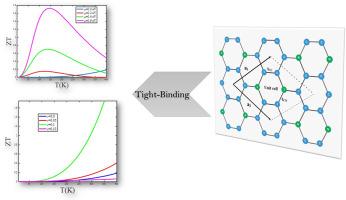Thermoelectric enhancement in C3N monolayer via external parameter modulation: Strain, doping, and magnetic fields
IF 2.9
3区 物理与天体物理
Q3 NANOSCIENCE & NANOTECHNOLOGY
Physica E-low-dimensional Systems & Nanostructures
Pub Date : 2025-07-18
DOI:10.1016/j.physe.2025.116332
引用次数: 0
Abstract
The search for high-performance thermoelectric materials is crucial for advancing energy conversion technologies. In this work, we unveil the remarkable thermoelectric properties of the C3N monolayer, a two-dimensional (2D) material with a tunable band gap of 0.36 eV. Using a combination of the tight-binding model and Green's function approach, we systematically explore the effects of tensile strain, electron doping, and transverse magnetic fields on key transport properties, including the Seebeck coefficient, thermal conductivity, and thermoelectric figure of merit (ZT). Our findings reveal that moderate tensile strain (ϵ = 0.1) significantly enhances ZT, while excessive strain (ϵ = 0.13) deteriorates efficiency due to increased electron scattering. Notably, electron doping optimizes the Seebeck coefficient and enhances thermoelectric performance by increasing carrier concentration. Furthermore, we demonstrate that a transverse magnetic field induces a semiconductor-to-semimetal transition by lowering the band gap, offering a new degree of tunability for electronic and thermoelectric applications. These insights not only establish C3N as a promising candidate for next-generation thermoelectric devices but also open new avenues for engineering 2D materials with optimized energy conversion capabilities.

通过外部参数调制C3N单层的热电增强:应变、掺杂和磁场
寻找高性能热电材料对于推进能量转换技术至关重要。在这项工作中,我们揭示了C3N单层的显著热电性能,这是一种二维(2D)材料,带隙可调为0.36 eV。结合紧密结合模型和格林函数方法,我们系统地探索了拉伸应变、电子掺杂和横向磁场对关键输运性质的影响,包括塞贝克系数、导热系数和热电优值(ZT)。我们的研究结果表明,适度的拉伸应变(ε = 0.1)显著提高了ZT,而过度的应变(ε = 0.13)由于增加了电子散射而降低了效率。值得注意的是,电子掺杂通过增加载流子浓度,优化了塞贝克系数,提高了热电性能。此外,我们证明了横向磁场通过降低带隙诱导半导体到半金属的转变,为电子和热电应用提供了新的可调性。这些见解不仅确立了C3N作为下一代热电器件的有前途的候选者,而且为具有优化能量转换能力的工程2D材料开辟了新的途径。
本文章由计算机程序翻译,如有差异,请以英文原文为准。
求助全文
约1分钟内获得全文
求助全文
来源期刊
CiteScore
7.30
自引率
6.10%
发文量
356
审稿时长
65 days
期刊介绍:
Physica E: Low-dimensional systems and nanostructures contains papers and invited review articles on the fundamental and applied aspects of physics in low-dimensional electron systems, in semiconductor heterostructures, oxide interfaces, quantum wells and superlattices, quantum wires and dots, novel quantum states of matter such as topological insulators, and Weyl semimetals.
Both theoretical and experimental contributions are invited. Topics suitable for publication in this journal include spin related phenomena, optical and transport properties, many-body effects, integer and fractional quantum Hall effects, quantum spin Hall effect, single electron effects and devices, Majorana fermions, and other novel phenomena.
Keywords:
• topological insulators/superconductors, majorana fermions, Wyel semimetals;
• quantum and neuromorphic computing/quantum information physics and devices based on low dimensional systems;
• layered superconductivity, low dimensional systems with superconducting proximity effect;
• 2D materials such as transition metal dichalcogenides;
• oxide heterostructures including ZnO, SrTiO3 etc;
• carbon nanostructures (graphene, carbon nanotubes, diamond NV center, etc.)
• quantum wells and superlattices;
• quantum Hall effect, quantum spin Hall effect, quantum anomalous Hall effect;
• optical- and phonons-related phenomena;
• magnetic-semiconductor structures;
• charge/spin-, magnon-, skyrmion-, Cooper pair- and majorana fermion- transport and tunneling;
• ultra-fast nonlinear optical phenomena;
• novel devices and applications (such as high performance sensor, solar cell, etc);
• novel growth and fabrication techniques for nanostructures

 求助内容:
求助内容: 应助结果提醒方式:
应助结果提醒方式:


